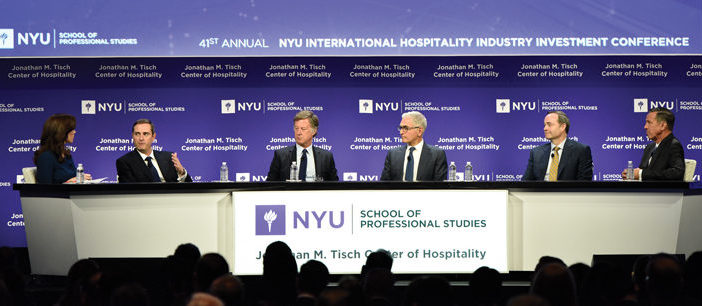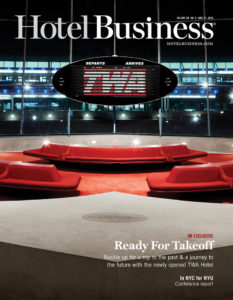NEW YORK—More than 2,300 hoteliers, investors, owners and vendors were on hand this year at the NYU International Hospitality Industry Investment Conference, held at the Marriott Marquis Times Square here, where session topics ranged from branding to the digital revolution, among others.
Several main industry challenges emerged from the conference’s panels, including brand proliferation, labor, construction costs and China.
Brands, brands and more brands
No matter the conference, one topic typically dominates the conversation: brand proliferation.
Moderator Kelly Evans, a journalist and anchor with CNBC, asked the executives on “The CEOs Check In: A View from the Top” panel, “What’s with all of the brands?” after verbally calculating the number of brands among the panelists (115 brands in total).
Arne Sorenson, president/CEO of Marriott International, which has a total of 30 brands, replied, “When we think about the 30, there is one umbrella brand, which is our loyalty program, Marriott Bonvoy. We’re providing choice for members of our program that is broad enough to keep them with us, as opposed to going to an OTA or Google or somebody else, and being an intermediated customer. If we don’t have a breadth of choice, the prospect of succeeding with the growing direct-owned customer portfolio is substantially weaker, which weakens the economics of every individual hotel in the system.”
Unlike its competitors, Choice Hotels International—which has 12 brands—has been taking a different approach to its brand portfolio. “Our efforts have been on revitalizing brands,” said Pat Pacious, president/CEO of the company. “We have a $40-billion real estate footprint that our franchisees know here in the U.S. We run those brands on top of that. Our Quality Inn brand, which started it all for us 80 years ago, had the highest number of openings in the midscale segment last year with 153 openings. That is attracting new real estate, not new-builds, but converting hotels to that brand.”
Instead of launching new brands to keep up with consumer trends, Choice updates its existing ones. “If your brand is viable enough and the economics make sense for that owner to put that investment into that existing asset and update it for today’s consumer, then it makes sense to update that hotel… Start with the ROI for that owner and you’re going to end up in a good place.”
Labor is a major challenge
“I think it’s labor,” Pacious said when asked about the industry’s biggest challenge. “I think it’s the rising labor cost and the global war for talent, whether it is someone who is working in your hotel or someone you hope to attract to your technology team. Labor and skills that are needed to help grow our business are getting more scarce, so it’s driving up the cost of labor, particularly skilled labor. The great news is unemployment is low, and that’s great for all of our businesses.”
This shortage is encouraging hospitality companies to think outside the box by looking elsewhere.
“In terms of tapping nontraditional sources for labor, our industry has a remarkable and powerful ability to make a difference in the world in the dimension of bringing people who are from disadvantaged backgrounds into the workforce,” said Mark Hoplamazian, president/CEO of Hyatt Hotels. “There’s a crisis around the world, often referred to as opportunity youth. Young people who are out of work and out of school and increasingly disenfranchised. We see this problem globally.”
To provide opportunities, last year, Hyatt, as part of its Rise High initiative, committed to hiring 10,000 disadvantaged youth. “Our industry is uniquely able to do that,” he said. “We need to pay attention to the fact that this gap in income and opportunity is present everywhere…we have an opportunity to make a difference in the world.”
Construction costs are rising
Labor and construction costs are going up, forcing companies to get creative with strategies and alternatives. The infiltration of dual brands, combining luxury and residential offerings, increasing construction times so costs can be better managed, and coming up with energy-related loans are all some of the ways the industry is keeping up.
“Overall, from a financial structuring standpoint, it does seem like the financing trends are still strong from the lender’s perspective with a couple of interesting twists for select-service owners,” said Leeny Oberg, EVP/CFO of Marriott.
Fellow panelists on “Leader’s Perspective: Current Cycle Realties: Transactions and Money” agreed that another solution could be the influx of offshore capital, with Oberg noting the increase of local capital invested in local deals.
“For example, the need to do a deal in Mexico with U.S. dollars: We’re finding good capital in pesos to do those deals. We’ve got a fairly moderate global economic picture with general low finance costs,” Oberg said, adding the overwhelming availability of investment opportunity in the Asia-Pacific.
China and the connected economy
“There’s this undeniable trend of population growth and wealth growth and the desire to travel,” said Steffen Doyle, managing director, Credit Suisse. “Right now, the U.S. is doing a bit of self harm. We have seen visitations going down from China into the U.S. A lot of that is being directed into Europe.”
“There are a number of points of conflict in the world today, geopolitical and economic, so the quicker some of those things get resolved and there’s a clear path to how things will work on borders or in relation to trade, the better off our industry will be,” Hoplamazian said. “Of course, the opposite is true; if there were something more cataclysmic to occur or a persistent ability to come to conclusion on some major policy issues, that will cause a persistent drag.
“As an adjacency, I was in Spain, last month and former President Obama was speaking, talking about the importance of travel and connecting people around the world to drive understanding and globalism,” said IHG CEO Keith Barr. “A longer-term risk is if more countries are building up nationalistic trends, that creates economic headwinds overall and puts challenges for the growth of the industry on a global basis.” HB
Check out our video interviews at video.hotelbusiness.com


